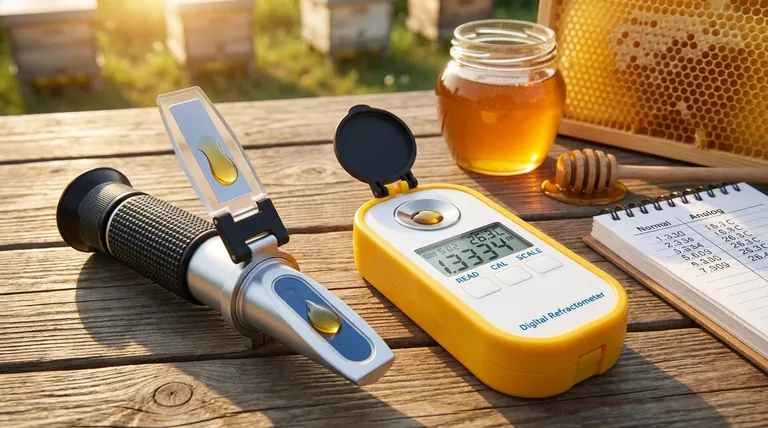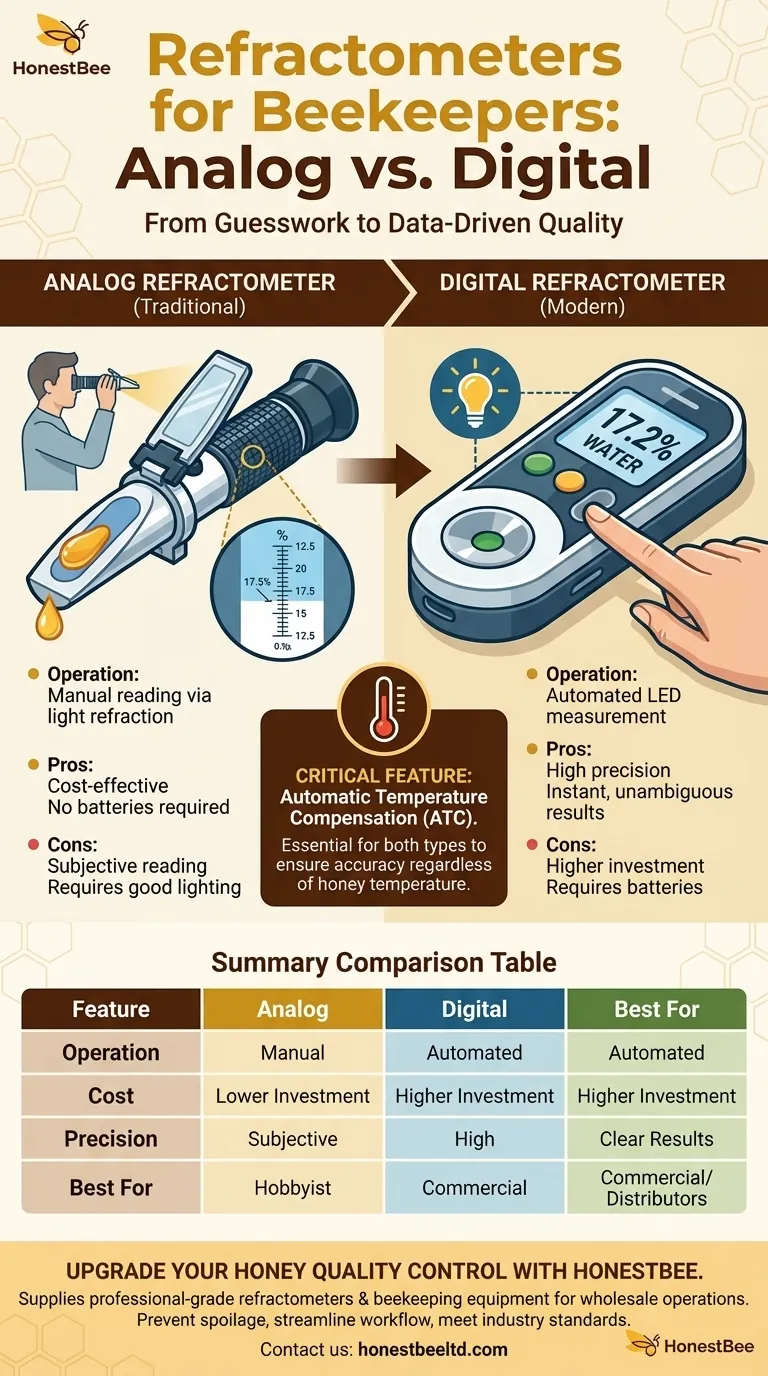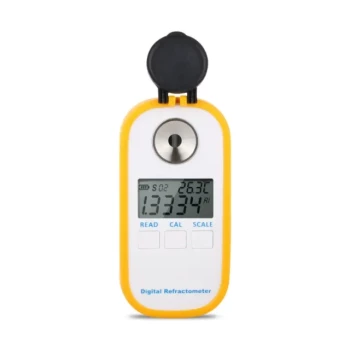For beekeepers, there are two primary types of refractometers: traditional analog models and modern digital models. An analog refractometer requires you to place a drop of honey on a prism, close a cover plate, and hold the device up to a light source to read the water content on an internal scale. A digital refractometer simplifies this process by using a built-in light source to provide a precise, numerical reading on a screen after a sample is placed in its well.
The core issue isn't choosing between gadgets; it's about gaining a scientific, data-driven method to determine honey's readiness. A refractometer measures water content, which is the single most important factor in preventing fermentation and ensuring your honey will store safely.

Why a Refractometer is a Critical Beekeeping Tool
Relying on traditional visual cues alone for harvesting can be imprecise. A refractometer provides an objective measurement, removing guesswork and giving you confidence in the quality and stability of your honey.
Preventing Fermentation
The primary goal is to measure the water content in your honey. Honey with high water content (typically above 18-20%) creates an environment where yeast can thrive, leading to fermentation that makes the honey fizzy, sour, and spoiled.
Ensuring Long-Term Quality
A refractometer helps you predict how your honey will behave in the jar. While low water content can sometimes lead to faster crystallization, the honey remains stable and edible. High water content, however, directly risks a spoiled harvest.
Meeting Industry Standards
For any commercial or semi-commercial beekeeper, using a refractometer is non-negotiable. It ensures your product meets established quality and safety standards for moisture content, which is critical for selling a consumable product.
Comparing the Two Main Types: Analog vs. Digital
While both tools accomplish the same goal, their operation and user experience differ significantly.
The Analog (Traditional) Refractometer
This device operates on the simple principle of light refraction. You apply a small honey sample to the prism, and as light passes through it, the internal scale shows the measurement. It is a reliable, time-tested tool that requires no batteries.
The Digital Refractometer
A digital model automates the measurement process. After placing a drop of honey in the sample well, you press a button. A built-in LED light source passes through the sample, and a sensor provides an exact moisture percentage on a digital display.
Unsuitable Refractometer Types
It is important to note that inline and laboratory refractometers are not designed for beekeeping. These are highly specialized, expensive instruments used for industrial process control or high-precision lab work and are not practical for testing honey in the field or honey house.
Understanding the Trade-offs
Choosing the right tool depends on balancing cost, convenience, and the need for precision.
Analog: Cost vs. Usability
The primary advantage of an analog refractometer is its lower cost. However, it can be more difficult to read accurately, especially in poor lighting conditions. The reading can also be subject to user interpretation.
Digital: Precision vs. Investment
A digital refractometer offers undeniable ease of use and highly accurate, unambiguous results. This precision comes at a higher initial cost, representing a more significant investment in your beekeeping equipment.
The Critical Factor: Temperature Correction
Honey's refractive index changes with temperature, which can skew your readings. Most quality refractometers—both analog and digital—include Automatic Temperature Compensation (ATC). This feature is essential as it automatically adjusts the reading to a standard temperature, ensuring your results are accurate and consistent.
Making the Right Choice for Your Apiary
Your decision should be guided by the scale of your operation and your primary goals.
- If your primary focus is hobbyist beekeeping: A quality analog refractometer with ATC is an excellent and cost-effective tool for ensuring your harvest won't spoil.
- If your primary focus is commercial production: A digital refractometer is a necessary investment for achieving consistent quality control, speed, and reliable documentation.
- If your primary focus is simplicity and accuracy: The digital model is the superior choice, as it eliminates the potential for user error and provides instant, clear results.
Ultimately, incorporating a refractometer into your process empowers you to make harvesting decisions based on data, not guesswork.
Summary Table:
| Feature | Analog Refractometer | Digital Refractometer |
|---|---|---|
| Operation | Manual reading via internal scale | Automated reading on digital display |
| Cost | Lower initial investment | Higher initial investment |
| Precision | Subject to user interpretation | High, unambiguous results |
| Best For | Hobbyist beekeepers | Commercial apiaries & distributors |
| Key Requirement | Must include ATC* | Typically includes ATC* |
*ATC: Automatic Temperature Compensation (essential for accurate readings)
Upgrade Your Honey Quality Control with HONESTBEE
Whether you manage a commercial apiary or supply beekeeping equipment distributors, accurate moisture measurement is non-negotiable for product quality and safety. HONESTBEE supplies professional-grade refractometers and beekeeping equipment designed for precision and durability in wholesale operations.
Let us help you:
- Prevent honey spoilage with reliable moisture testing tools
- Streamline your workflow with equipment built for commercial use
- Meet industry standards consistently with professional-grade gear
Contact us today to discuss your specific needs and explore our wholesale-focused product catalog. Get in touch via our contact form to ensure your honey harvest is stable, safe, and market-ready.
Visual Guide

Related Products
- Digital Honey Refractometer for Precision Measurement of Optimal Honey Quality
- Precision Honey Refractometer Instrument for Quality Assessment
- HONESTBEE 72 Frame Industrial Electric Honey Extractor for Beekeeping
- 8-Frame Electric Self-Reversing Honey Extractor Spinner for Commercial Honey Extraction Equipment
- 2 Frame Stainless Steel Manual Honey Spinner Extractor for Beekeeping
People Also Ask
- Do hobbyist beekeepers need a honey refractometer? Ensure Your Honey Harvest Is Perfectly Preserved
- What are the benefits of using a Pocket Digital Honey Refractometer? Achieve Precision & Speed in Honey Quality Control
- How should a honey sample be prepared for accurate readings? Ensure Purity and Temperature Stability
- Why is temperature important when using a honey refractometer? Ensure Accurate Moisture Readings
- How is honey applied to the refractometer? Ensure Accurate Moisture Content Measurement



















